| Revell Darth Vader's TIE Fighter in 1/72 |
| Start:
December/2009 Finished: January/2010 |
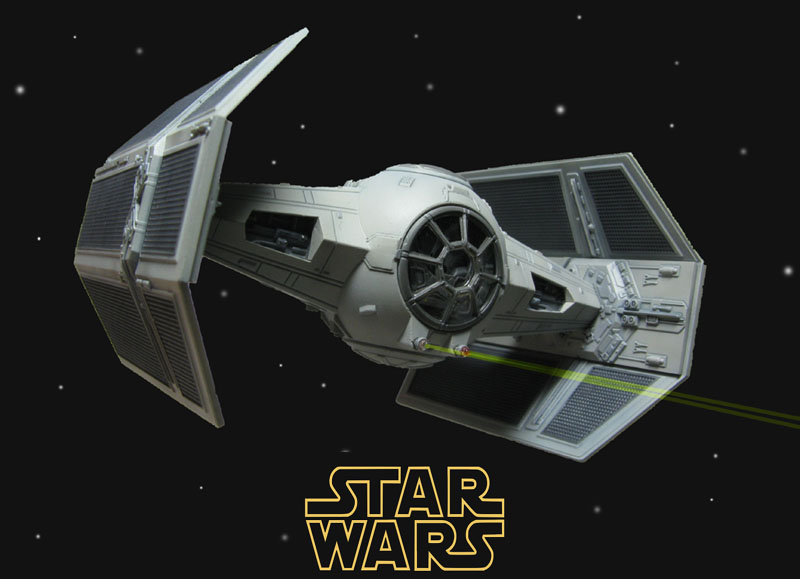
...Let me explain: I've never built a model of something without a history, documentation and all sorts of records to back it up. But then, again, this one is not fiction, in case you are wondering. TIE fighters did exist. Here is a bit of history:
The TIE fighters background
Contrary to popular belief, the name TIE has nothing to do with what you wear in weddings. The name bears the basic propulsion technology used in a extense family of military ships produced by Sienar Fleet Systems. TIE is an acronym for Twin Ion Engine, even though many ships bearing the name had three or four ion engines. More on that later. The former Republic Sienar Systems developed the original TIE fighter that would become the forerunner to the standard Imperial vessel. After Palpatine took the power, the rechristened Sienar Fleet Systems became the exclusive manufacturer of starfighters for the Imperial Starfleet.
The whole TIE family encompasses some of the most formidable ships used by the Empire, including the feared TIE Interceptor and the TIE Bomber. With the Empire's leadership transition came the upgrated TIE, which went under continued revisions until the TIE/ln became the standard line starfighter in Imperial use. Here we will restrict outselves to the fighter family. There is some controversial opinions about the strenghts of these little fighters. Some examples:
"TIE fighters were typically employed en masse to make up for their shortcomings. Speedy and maneuverable, these fighters are nonetheless fragile. Though hard to hit, even a glancing blow can destroy a TIE."
"The TIE Fighter has proved itself in battle, as it is capable of with standing many direct hits. In addition the pilots' chances of survival were considerably enhanced by the incorporation of a hyperdrive system, which enables the ship to escape from hopeless battle situations."
Though TIEs presented a formidable challenge to pirates and civilian craft, the skilled pilots of the Rebel Alliance made short work of them in combat. The Alliance workhorse, the T-65 X-wing starfighter, continually bested the TIE in numerous engagements. As the Galactic Civil War raged on, the standard TIE arsenal was supplemented with more advanced and specialized craft.
The hexagonal solar panels supply power to a unique propulsion system. Microparticle accelerators propel ionized gasses at a substantial fraction of lightspeed. These gasses are then expelled from rear vents to generate thrust. The ion streams can be directed along almost any vector, allowing for the TIE's incredible velocity and maneuverability. The twin ion engines have few moving parts and require comparably less maintenance to the starfighters of the Alliance.
TIE fighter units are typically organized into wings -- a grouping of 72 fighters carried aboard a Star Destroyer. These wings are subdivided into six squadrons of 12 fighters each.One of these squadrons is typically made up of TIE interceptors while another consists of TIE bombers. Each squadron consists of three flights of four fighters each. Each flight contains two elements. An element is the smallest tactical unit of starfighters ever deployed, and consists only of a leader and a wingman.
TIE production was extremely modular and automated, as the Sienar foundries churned out countless starfighters to fuel the insatiable Imperial war machine. Variant models of the basic TIE include the TIE/rc (a model with advanced sensors and communication gear for reconnaissance missions), the TIE/fc (equipped with accurate fire control and target designation for long-range naval bombardments), the TIE/gt (with an enlarged hull to deliver heavy ordnance).
Technology
The exerpts below were taken from Star Wars Technical Commentaries:
Each engine generates a stream of charged particles which are hurled at relativistic speeds and channelled through nozzles at the back of the ship. The exit of particles imparts a thrust to the ship in the opposite direction, which is the same kinematic principle as underlies chemical rocketry. The tight acceleration and streaming of the invisible particles is achieved by powerful applied electromagnetic fields. The fields at the nozzle's aperture can be manipulated to divert the stream, allowing the thrust to be angled anywhere in a wide arc of possible directions. The independent vectoring of the streams from the two engines allows for extremely dynamic manoeuvring.
The engine nozzles are seen as glowing red circular areas and are visible only from directly behind the ship. Not all ships in this series literally fit the "TIE" name. Some have different numbers of engines. Lord Vader's custom fighter, for instance, has four ion engines and should rightly be called a "QIE": "Quadruple Ion Engine". Other vessels, like the TIE Defender, with its three-fold symmetry, have different numbers. (Ships with quadruple engine nozzles might actually share one engine per nozzle in the ship's interior, but the lack of space in the hull globe makes this seem unlikely; and the symmetry of the three-fold fighters appears to be too fundamental for a split engine/nozzle explanation.) The engines of the TIE scout, bomber, boarding craft and transport are difficult to locate and count using presently-available images. Counting the engines of different models is an interesting exercise which may tell us about the propulsive capabilities of the various craft.
TIE fighters have enormous accelerative capabilities for their size. They can effortlessly make orbit from the surface of a habitable world, which implies that their onboard energy sources are much greater than 6x107 joules per kilogram of the ship's mass. This is the bare minimum needed to reach escape velocity from the surface of an Earth-like world. The same feat involving a planet of Bespin's size would require more than nine times as much energy. The fleet of star destroyers in Return of the Jedi moved into its attack position with a nett deceleration magnitude of at least 4000g [Earth gravity]. Starfighters are considerably faster. An Imperator-class star destroyer can marginally outrun the Millennium Falcon in linear sublight acceleration, and most TIE models are significantly faster than the Falcon. Therefore most TIEs are capable of straight-line accelerations and decelerations on the order of at least thousands of g, no less than some tens of thousands of m/s².
Devices called inertial dampers are employed to prevent these accelerations from destroying the pilot and instruments. This is a commonplace use of artificial gravity technology, which applies a force to the ship's interior, varying to exactly counterbalance the inertial forces caused by external acceleration and manoeuvres. Inertial dampers have practical limitations. Sometimes a force is too violent or sudden for the compensators to adjust and counterbalance, leaving a potentially deadly residual force. The safety limits of inertial integrity may be one of the chief determining factors of starfighter performance. Because starfighters are subject to worse accelerations than commercial vessels, they should be fitted with a higher grade of inertial dampers. Nonetheless, many pilots turn down their dampers slightly, so that they experience a tiny fraction of the true acceleration. This aids a pilot's intuitive physical sense of his craft's motion.
Some, if not all, TIEs possess repulsorlift generators for movement close to a planetary surface. This is particularly useful for unaided emergency landings. Normally, TIE fighters are berthed and manipulated using docking bay tractor beams in the mothership or base. Most combat TIEs lack any kind of landing gear; the preferred docking position is hanging from a specialised rack with gantries to provide access for pilots and service crew. In some comics and novels evidence suggests that the wings can actually bear the weight of an unpowered fighter, but this might simply be a case of leaving the repulsorlifts active while parked. The heavy TIE transport ships rely entirely on a set of landing pads because of its enormous weight, and the wings are deliberately raised so that they can never touch ground.
Most TIE combat ships lack hyperdrives. This mass-reduction adds to sublight flight performance, and it is not a serious tactical or strategic restriction. Since the Imperial forces can send enormous warships or surface garrisons virtually anywhere in the galaxy, there was no shortage of potential motherships or bases for short-range fighter missions.
Lord Vader's TIE X-1
Darth Vader's TIE Fighter in the Battle of Yavin, with just over 9 m long, is the prototype that was used as the basis for all the terrifyingly effective TIE Fighters and Interceptors that would be developed for future battles. Typical for this spaceship are its jagged wings and its deflector shield generator. A bit of terminology is in order here:
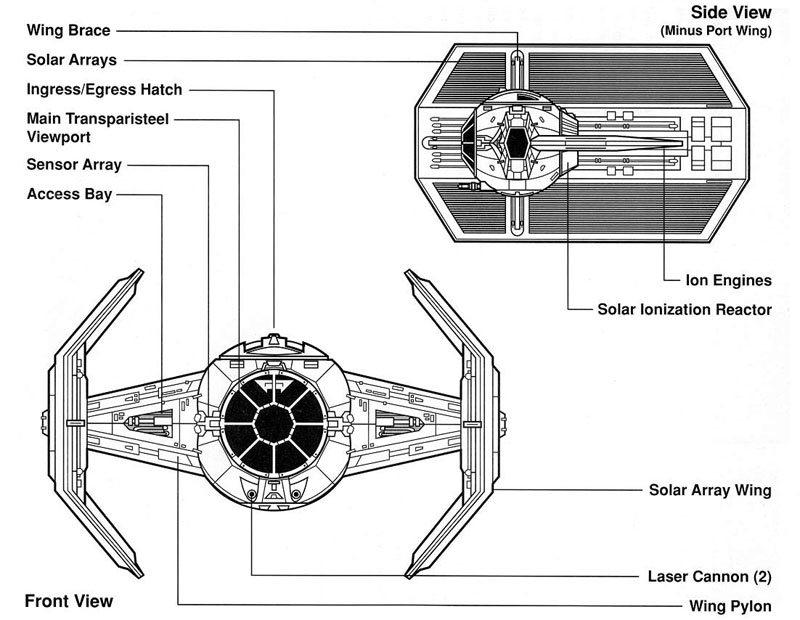
Lord Vader's personal TIE Fighter was armed with heavy twin blaster cannons on fixed mounts, with a hull made of duralloy steel and unique solar cell wings. Long-range TIEs were not new by then, however. Lord Vader's advanced TIE prototype was hyperspace-capable, and sometimes regarded as a custom or deluxe design, but this may be just a figment of hindsight, since this class became a source of inspiration for the later, famous Interceptor and Avenger models. This heavy fighter may actually have been a commonplace long-range fighter design used throughout much of the history of the Empire: according to blueprints, the star destroyer Imperator (the first of its class) originally carried a number of unipod bent-wing TIE assault craft.
The "customisation" of Vader's personal TIE might actually extend no further than its provision of shields (This is a distinctive feature; most TIE fighters are unshielded and rely on superior piloting skill and tactical advantage). Alternatively, the modification might involve the partial removal of shields or targeting systems, since Vader's excellent piloting skills are augmented by his mastery of the Force. Perhaps the speed or the power of the weapons have been enhanced. Perhaps the customisation involves life-support in the cockpit; Vader's fighter might optionally provide him with an environment similar to that created in his hyperbaric meditation chambers.
In any case, this fighter is significantly faster and more manoeuvrable than its mass would suggest. Four thruster nozzles are placed in two pairs above and below the extended tail of the fighter. This section, containing a shield and hyperdrive units, blocks the usual cockpit rear viewport. Therefore a realistic holographic viewscreen is mounted behind pilot seat to mimic the rear window found in ordinary TIE starfighters. Judging by cockpit interior details, the main hatch is still at the rear of the ship, but the mechanism by which it opens must be more complex than for TIEs with a simple unadorned hull pod.
The wing pylons are thicker than usual,
and there are large holes in their front faces.
Through these gaps, a set of curved pipes can be seen.
The pipes run in the same general direction,
from the main hull towards the wings.
These probably carry outbound coolant.
The partial exposure of these pylon pipes to space may be a
modification
to further improve the removal of excess heat.
The long-range TIE Scouts also possessed fully functional hyperdrives,
for obvious reasons.
Behind the scenes
The
TIE fighter design was first established in a concept model by
Colin Cantwell. The simplified model defined the TIE's most distinctive
features: its ball cockpit and twin hexagonal wings. Subsequent
sketches built up the TIE's form. Limitations in visual effects
technology at the time dictated that Cantwell's blue color scheme be
replaced with a more bluescreen-friendly gray. As the classic trilogy
progressed, the TIEs regained a bit of their blue hue, although use of
that color was fairly muted.
The distinctive scream of a TIE fighter's engines came from sound
designer Ben Burtt mixing the sound of cars streaking by on a
rain-slicked highway and the trumpeting cry of an elephant.
Although literature attests that TIEs lack such pilot-friendly features
as ejection seats, LucasArts' popular TIE fighter simulator game of
1995 showed that at least some Imperial units retrofitted the life
saving devices into the craft. After all, it wouldn't do to have
players die after every botched mission.
The Revell EasyKit model
This kit is clearly devoted to occasional collector/fan, but I'm sure it made its way in many younsters' Christmas tree. It comes in a blister with about a dozen parts molded in blue/gray. All parts are very well molded - there was absolutely no flash anywhere in my sample. Panel lines are recessed and thin, with many details molded as raised/overlapping areas. All dark gray areas are pre-painted. This is done at factory using masks, and as you can probably guess, the alignment of them is far from perfect. In my sample, the clear parts had a serious mask misalignment, having more paint applied over the windows than on the frames. But it is very cheap...
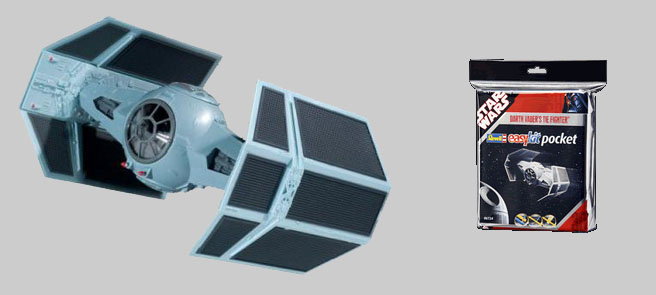
I started with the cockpit. There I used a gray tone slightly darker than the external color, then applied a oil wash followed by a heavy drybrush with light gray. Smaller details were picked in white, silver, blue and yellow, but not much of it can be seen. The drybrushing, however, proved to be a good idea, as several raised details showed up later in the finished model. I spent some time with Lord Vader himself, hoping to see his characteristic helmet when looking from outside. For such, I painted it with semi-gloss black, washed with burnt-sienna oil paint and glossied the boots, gloves and helmet with two good coats of Future.
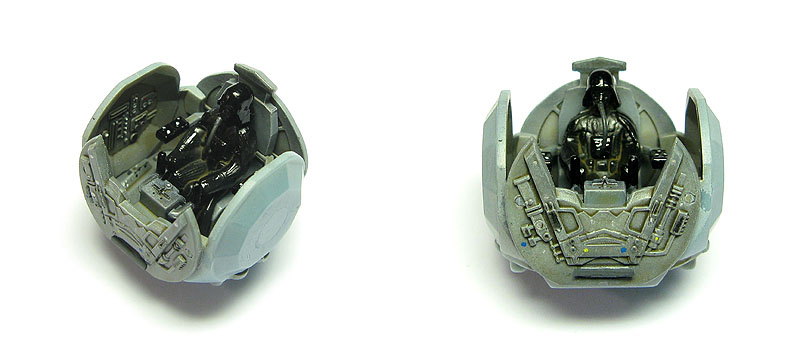
After removing the paint from the transparesteel viewport, I masked it and dry fitted everything to make sure the hull would close properly. The access bays on the wing pylon roots were also painted and installed, but I added plastic shims to blank off the hull seams, because it would be impossible to sand them after glueing the hull halves.
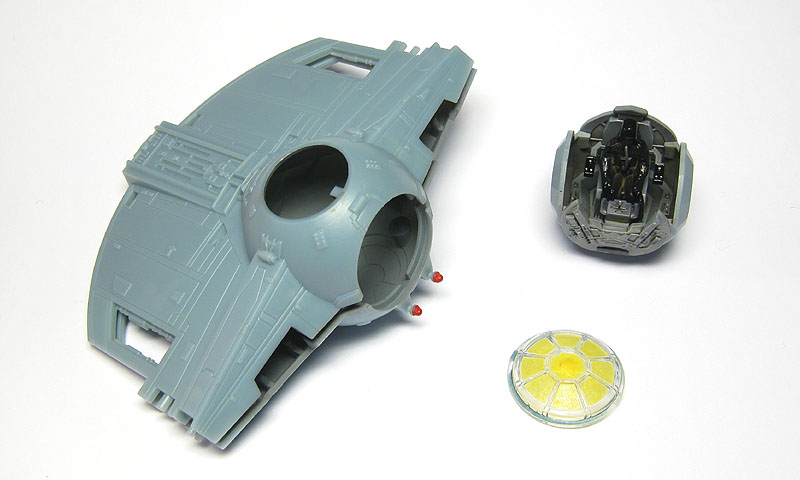
Note that the laser cannons are also pre-painted in red. Later I would get rid of them... The only deviation from the instructinos were some bogus details added to the upper and lower areas of the ion engines to add interest.
Next, I played with my new Grex airbrush using a bit of modulation during the painting phase. I started with a usual pre-shading using Tamiya Nato Black (XF-69). Then, Gloss White (X-2) was applied on a few panels to act as modulators of the final color. No masking used here. Just pure fun with a fine tipped airbrush. As for the main color, I took into account that it should have a tad of blue hue (see Behind the scenes, above), but I did not want the ship in a light blue tone. The pic below is from the actual model used in the original trilogy. As you can see, essentially three tones of gray are in order: a main cammo light gray, a dark (almost black) gray for the solar arrays, and another, slightly lighter than the last, to paint details on access hatches/panes and viewport frames.
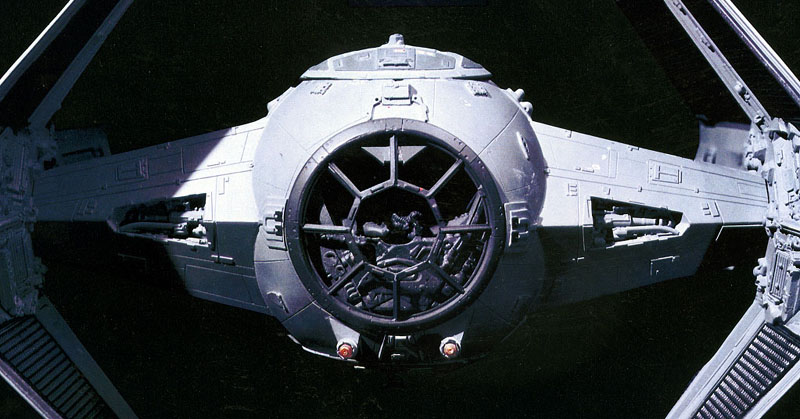
The frame below is a still from one of the films, showing that the blue hue is there, although this is visible only under certain lightning.
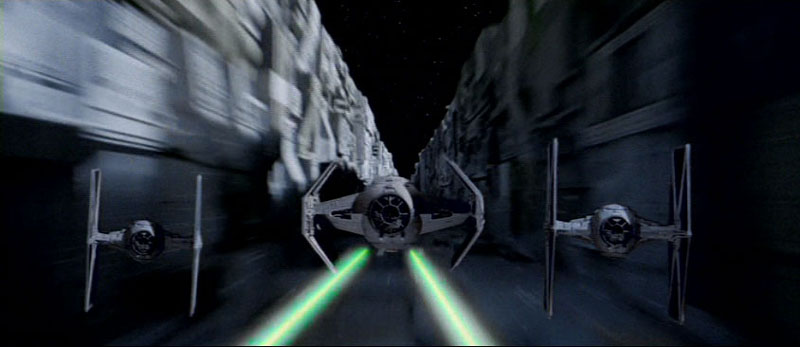
Since the plastic used by Revell was already blue, I decided to go the easy way by simply superposing light mists of Gunze Gray FS26440 from their Aqueous line (H-325). Unfortunately, the photos below were taken with less than desirable light, but I was very satisfied with the modulation obtained. After letting the gray to dry, I accented some raised panels by handbrushing a darker gray using Vallejo paints:
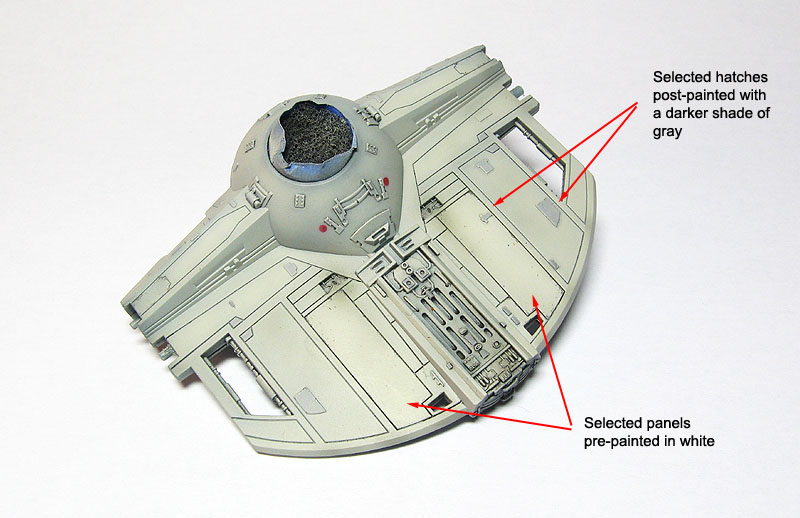
The engine areas then received a wash of dark brown/black oils. For the most part of the panel lines, however, I used a sludge wash with Payne's gray, which is actually a sort of dark blue, so much of the desired blue hue was recovered during this phase.
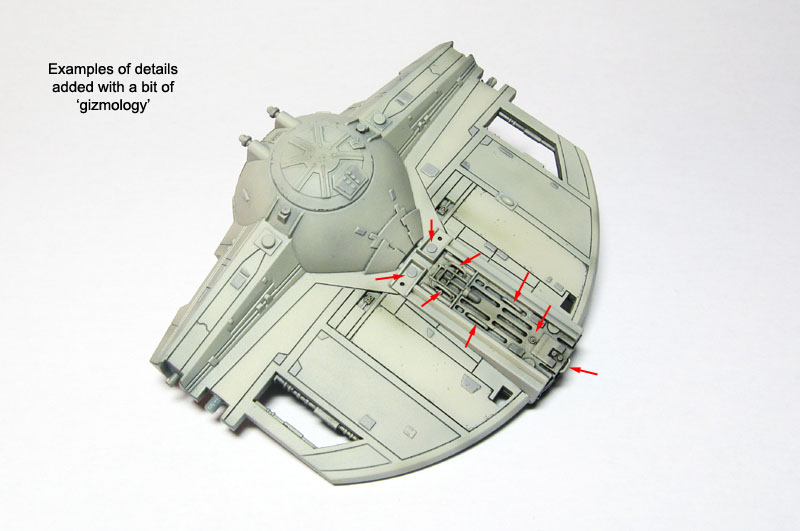
Post shading was limited to highly thinned Gunze's Smoke Gray (H-95) applied on deep recesses and engine area. After waiting everything to dry overnight, I applied a semi-gloss clear coat consisting of 70% matt and 30% gloss from Vallejo paints. After another night drying, I proceeded with a drybrushing with light gray/white oil paints. Although I am progressively abandoning drybrushing as a post shading measure, it still is a very trouble-free method for highlighting crisply molded details, as is the case here:
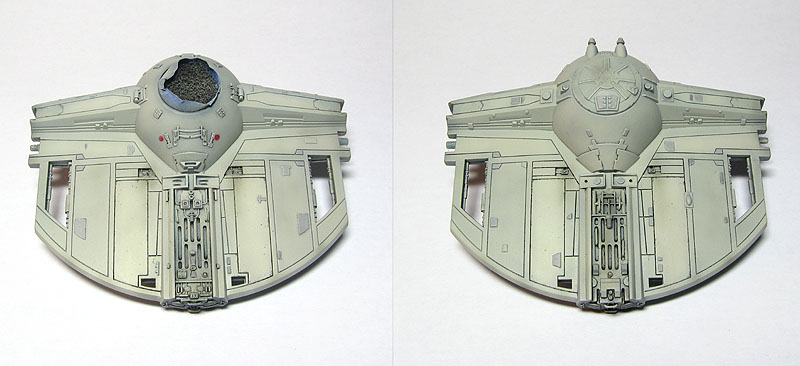
Essentially the same sequence was used on the inner panels of the wings, bringing to life numerous molded-on details. Darker details on the access hatch and viewport frames were painted with the same gray of the main color mixed with black.
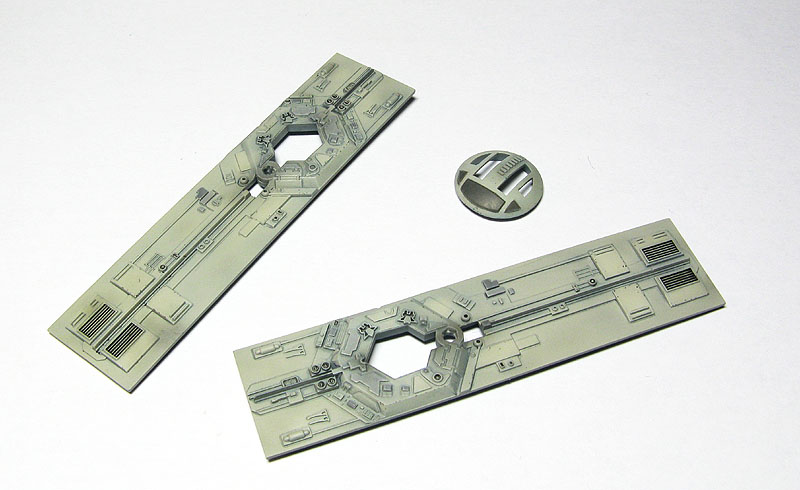
The same treatment was applied to the wings too, except that I had to waste a lot of time masking the solar array panels after the main color. These were painted with Vallejo Dark Gray:
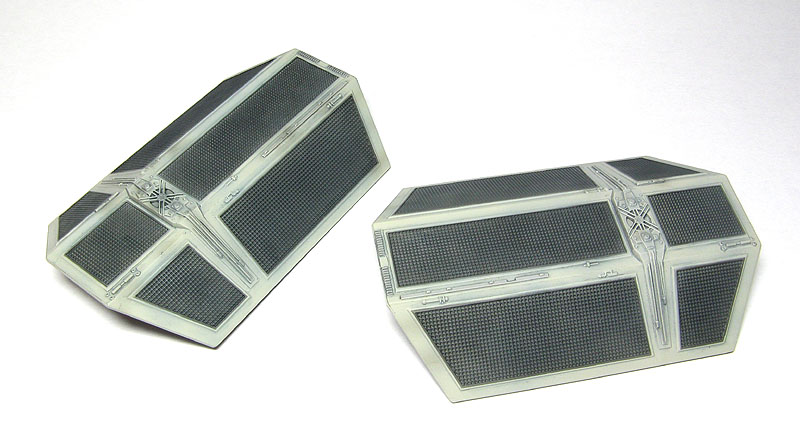
The final touch was to simulate paint chipping/scratching (I know, I know they fly in the outer space, but what about the maintenance crews?) using a 2B pencil on edges and corners of what I suppose to be service panels. Before proceeding to final assembly, I sawed off the solid cannon muzzles and replaced by rounded pieces clear sprue. They were polished and glued with a liquid glue/red enamel mix.
Finally, the access hatch was plugged in place with the corresponding clear part (no glue necessary), and the wings were literally clicked in place (yes, glue necessary).
The base was made from the case of a cheap thermometer, cut to size, sanded smooth, and painted with Krylon semi-gloss black. It almost gave me more work than the model itself! The support is a piece of Aluminum tubing which slots in a previously drilled hole on the belly of the little TIE.
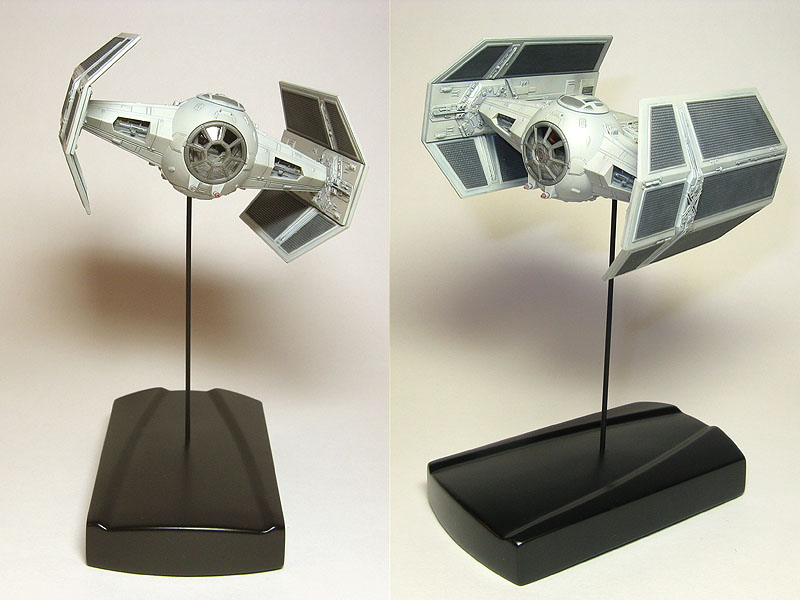
Now, some dramatic photos:
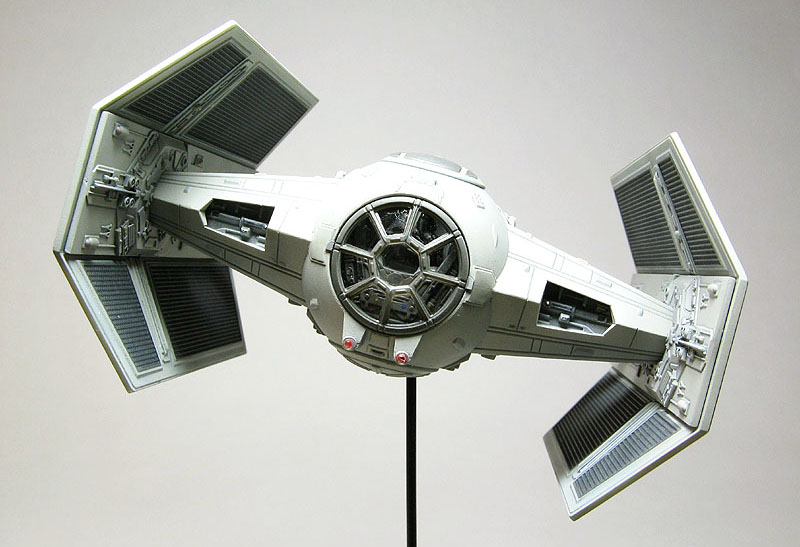
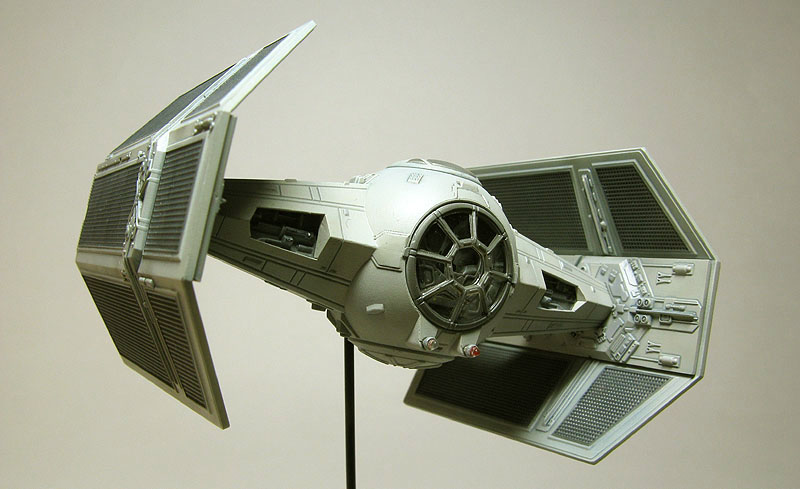
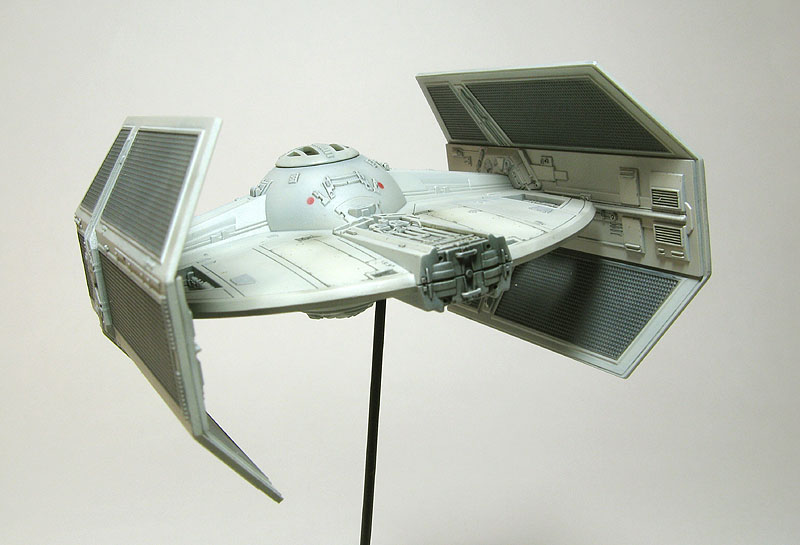
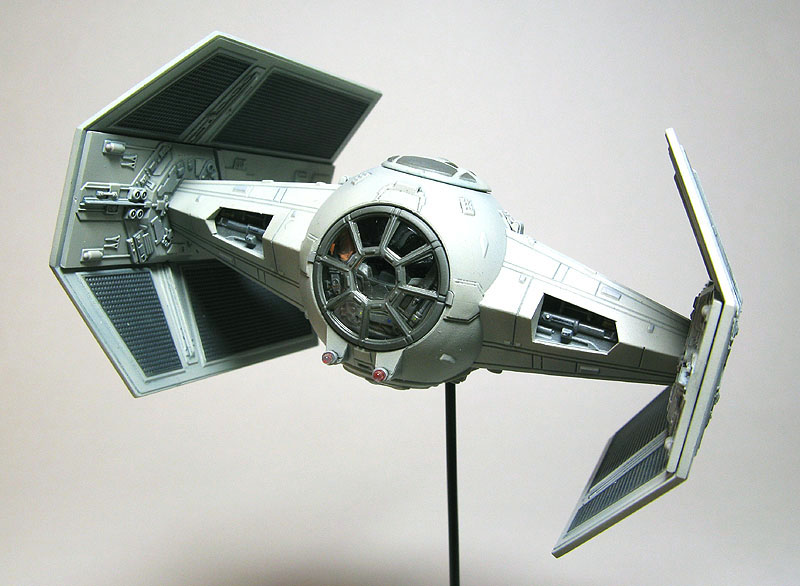
I still have to add a little plaque atop of the base... or maybe a Star Wars logo? I'm accepting suggestions...
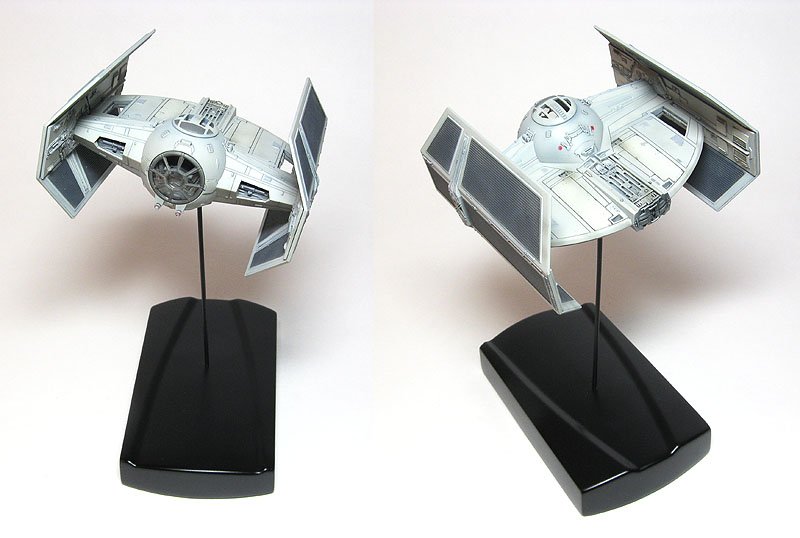
I had fun with this project. It was quick and painless - no propellers, no landing gear, no decals, but I doubt I will be building more of these in the future. More importantly, it helped to keep my sanity by actually finishing something while away from home.
And yes, the first image of this article was made using this model and some photo-retouching...
| Technical file | |
| Kit:
|
- Revell 06724 |
| Additions:
|
|
| Basic
colors: |
-
Primer: None - Light Gray: Gunze Aqueous Gray FS26440 (H-325). - Dark Gray: Vallejo Dark Grey (#166) - Semi-gloss clear: 70% Vallejo Model Color Gloss Varnish (#510) + 30% Vallejo Model Color Matt Varnish (#520) |
| Notes: |
|
Rato Marczak © 2010
